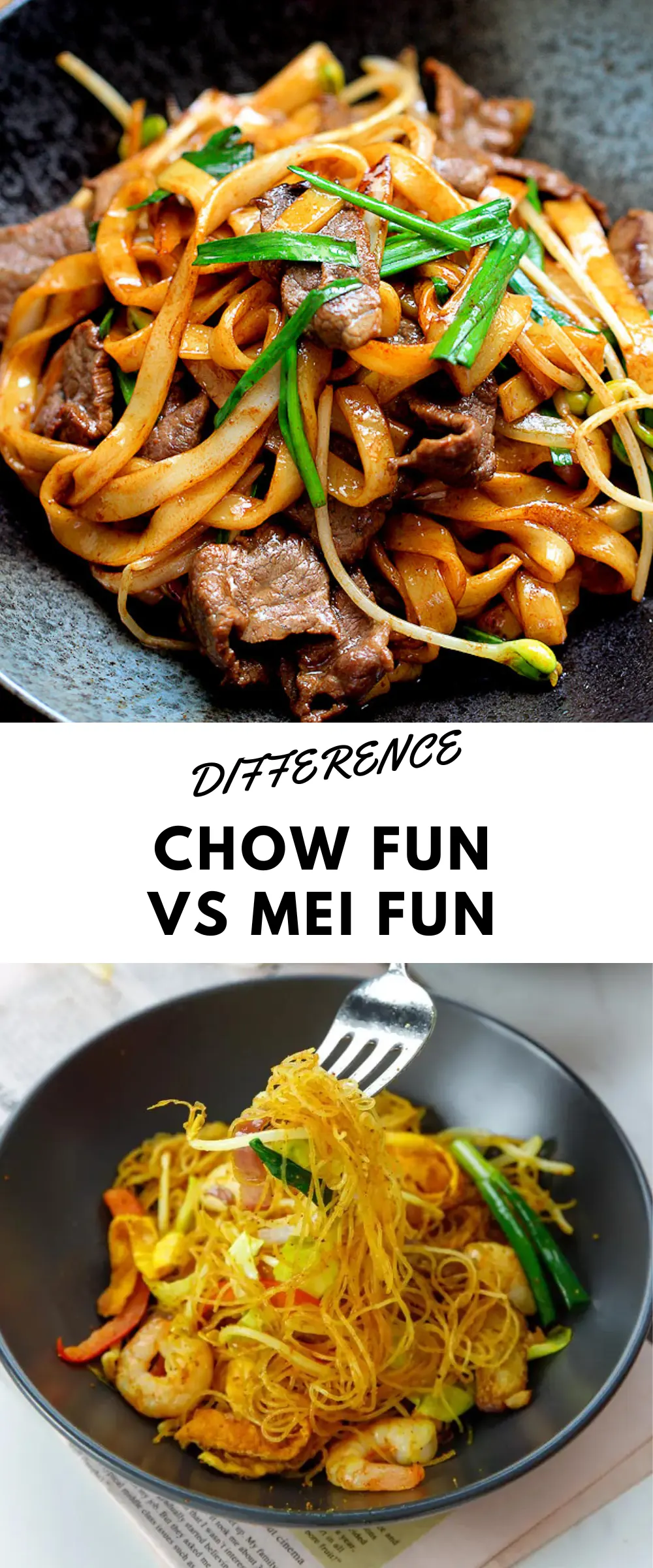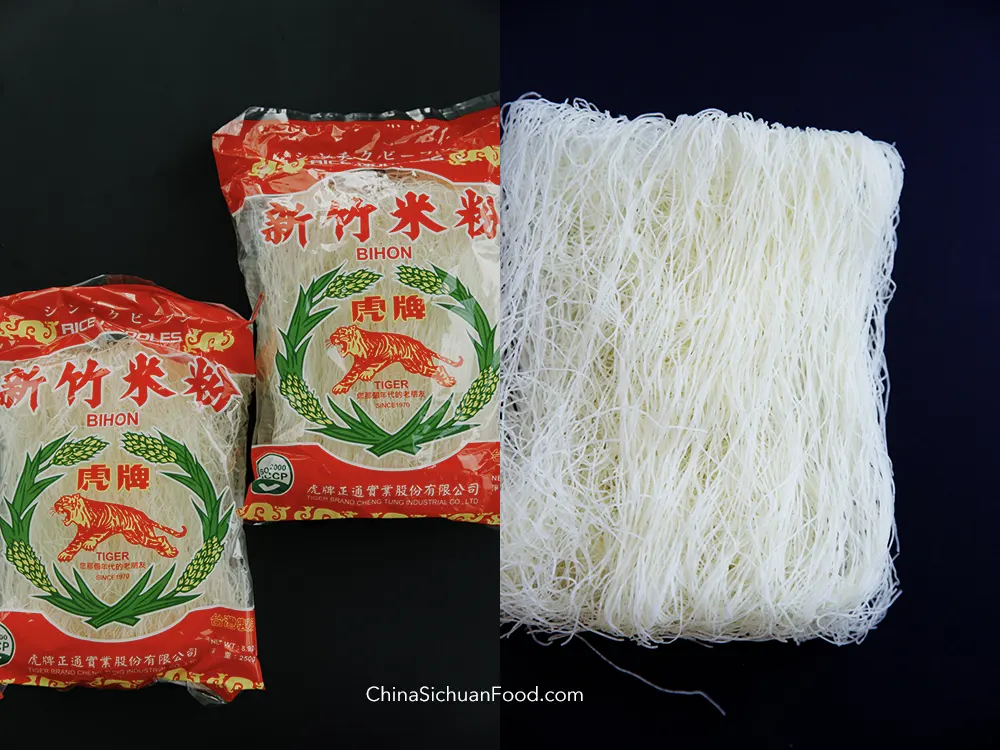Mei fun and chow fun are the most popular noodles in Asian cuisine. You may wonder what’s the difference. Let’s explore more about the two yummy noodle ingredients.

Mei Fun Vs Chow Fun: Origin difference
The Guangdong province in southern China is where chow fun noodles first appeared. They have long been a mainstay of Cantonese cooking, and in locations like Hong Kong, they are a common street item. The wide, flat shape of chow fun noodles, manufactured from rice flour, makes them popular.
On the other hand, mei fun noodles originated in South China and other Southeast Asian nations. Although they are created from the same rice flour as chow fun noodles, they are thinner and more delicate. Mei fun noodles are common in meals like Bun Cha Gio and Pad Thai and are frequently used in Vietnamese, Thai, and other Southeast Asian cooking styles.
So Mei fun is more widely used than chow fun.
Mei Fun vs Chow Fun: ingredients
The two shares similar ingredients: water, rice flour, and sometimes starch.
Rice flour and water are combined to form a dough, which is then steamed to create chow-fun noodles. Wide, flat noodles are then made from the dough and utilized in stir-fries, soups, and other cuisines. The dough may occasionally be enhanced with cornstarch or tapioca starch to enhance its texture and soften the noodles.
Contrarily, mei fun noodles are produced from a combination of rice flour, water, and occasionally cornstarch. After that, the dough is extruded via a device to produce rice vermicelli, which is thin, delicate noodles. Mei fun noodles have a somewhat stiffer texture than chow fun noodles because of the starch content.

Taste
Chow fun noodles have a soft, slightly chewy texture and a mild rice flavor. They are versatile and can be used in many different dishes, from stir-fries to soups, and absorb the flavors of the sauces and ingredients they are cooked with. When served in dishes such as Beef Chow Fun or Char Kway Teow, the soft texture of the chow fun noodles provides a satisfying contrast to the other ingredients. They are mostly served with thick-cut meat, veggies, and thicker sauce and seasonings.
On the other hand, mei fun noodles have a delicate texture and a mild flavor that pairs well with lighter, more refreshing dishes. They are often used in soups and cold noodle salads, where their thin, silky texture and ability to absorb flavors make them an ideal base for other ingredients. In dishes such as Bun Cha Gio, the mei fun noodles provide a delicate contrast to the grilled pork and fresh herbs. Mostly served with veggies and meat, dipped in soy sauce, oyster sauce, and other Asian condiments, i.e., curry powder.
Appearance
Chow fun noodles are typically about ¼ inch in width. They have a soft, slightly chewy texture and a smooth surface. The flat shape of chow fun noodles makes them ideal for stir-fries and dishes where they can absorb sauces and flavorings. Chow fun noodles are often served in wide strips or sheets cut into shorter lengths.
In contrast, mei fun noodles are typically around 1-2mm in width. They have a translucent appearance and a soft, almost silky texture. Unlike chow fun noodles, mei fun noodles are cylindrical and often served in loose bundles or coils. The delicate texture of mei fun noodles means that they are often used in soups and salads, where they can be quickly cooked and served without becoming too soft or mushy.
Package
Both mei fun and chow fun can be found in dried forms. However, fresh chow fun can also be packaged in air-tight bags.
Following is a table showing the difference between chow fun and Mei fun
| Factors | Chow Fun | Mei Fun |
| Popularity | Guangdong, China | China and other Southasian countries |
| Size | Thick rice noodles | Thin rice noodles |
| Ingredients | Rice flour + water = combined to form a dough = then steamed to create chow fun noodles. | Mei fun noodles are produced from a combination of rice flour, water, and occasionally cornstarch. |
| Appearance | 1/4th inch in width, soft and chewy | 1-2mm in width, soft and silky texture |
| Taste | Does not have a strong flavor and can easily take up the flavor of the fellow ingredients it is cooked with. | A slightly more delicate flavor than Chow Fun |
| Nutrition | In a 100-gm portion, chow fun provides 26 gms of carbohydrates. | In a 100-gm portion, mei fun provides 25 gms of carbohydrates. |
What is Chow Fun?
Chow fun noodles are a type of Chinese noodle made from rice flour, also known as Ho fun. They are known for their wide, flat shape, which is different from other noodle varieties that are long and thin.
One of the great things about chow-fun noodles is that they have a unique texture that is both soft and slightly chewy. When cooked properly, they have a satisfying bite that makes them a pleasure to eat.
Chow fun noodles are an important part of Chinese dishes. Think stir-fries and soups. You can also pair these noodles with beef, chicken, shrimp, vegetables, and sauces for an authentic experience.
Talking about a classic dish that features chow-fun noodles, Beef Chow Fun is a stir-fry including sliced beef, bean sprouts, and scallions. The noodles are cooked in a hot wok with the other ingredients and then finished with a savory sauce.
Chow fun can also be used in soup noodles like this beef ho fun noodle.
What is Mei Fun?
Mei fun noodles are thin, delicate rice noodles made from rice flour and water. They are a bit translucent and hence prove to be an elegant addition to any dish.
Like chow fun noodles, you can pair mei fun noodles with many dishes, from stir-fries to soups to salads. They are an important part of Vietnamese and Thai cuisine. These are typically served with soy sauce and sesame oil.
When cooked, mei fun noodles have a flavor profile that blends sweet, sour, salty, spicy, and savory sensations all in one mouthful. Over the years, these noodles have gained popularity in China and other areas of the world. They are also incredibly absorbent, soaking up all the delicious flavors of the dishes they are in.
One classic dish that features mei fun noodles Singapore mei fun in which char siu, shrimp, lots of vegetables, and curry powders are mixed.
Another popular dish that uses mei fun noodles is Bun Cha Gio. It is a Vietnamese noodle salad that features grilled pork, spring rolls, and a variety of fresh herbs and vegetables. The noodles add a delicate touch to this flavorful salad.
But the beauty of mei fun noodles is that they can be used in many different ways. You can add them to soups for a bit of texture, use them in cold noodle salads for a refreshing dish on a hot day, or even deep-fry them for a crispy snack.
Calories
With a 100-gram portion, mei fun can give up to 25 grams of carbohydrates, whereas chow fun can do the same with up to 26 grams. Since they share similar ingredients, the calories are similar too.
Final Thoughts
Cchow fun and mei fun noodles are two delicious and unique rice noodles enjoyed for centuries in various Asian cuisines. Both noodles have distinct characteristics, from the wide and chewy texture of chow fun to the delicate and silky texture of mei fun.
Whether you are a fan of stir-fries, soups, or noodle salads, chow fun, and mei fun noodles offer mouth-watering magic that will satisfy your cravings and leave you wanting more. So, the next time you’re in the mood for a delicious and satisfying noodle dish, consider trying out one of these beloved rice noodles and taste the magic!
